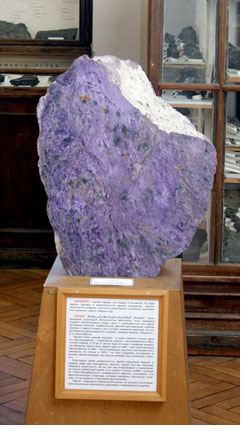 CHAROITITE is a rock consisting mainly of lilac charoite and dissemination of other minerals: black acicular aegirine, golden brown tinaxite, greenish kanasite, gray quartz, etc.
CHAROITITE is a rock consisting mainly of lilac charoite and dissemination of other minerals: black acicular aegirine, golden brown tinaxite, greenish kanasite, gray quartz, etc.
CHAROITE (K,Na)3-4(Ca,Ba,Sr)5[Si12O30]×nH2O has an exceptionally beautiful texture. Fibrous crystals of this mineral create unique patterns, often with a silky or pearly shine. An amazing purple-lilac colour is associated with the presence of manganese admixtures in its composition; its brownish varieties contain iron impurities. Mohs hardness scale is 5.
Charoite is an exceedingly rare mineral, only single its deposit is known in the world, Sirenevy Kamen in Eastern Siberia, 70 km from the Chara River (hence the name of the mineral). Charoite was first found here in 1949 during geological mapping. In 1962, large accumulations of this mineral were discovered, but it was not until 1978 that it was studied in detail and soon registered as a new mineral under the name “charoite”.
Due to its uniqueness, bright lilac colour and rare beauty, even for gems, charoite quickly gained worldwide fame. It still fascinates and attracts not only stone lovers, but also scientists. Only in 2009, scientists from St. Petersburg University managed to establish its crystal structure, which turned out to be so complex that it was called the “structure of the decade.”
Charoite is a jewellery and ornamental stone, from which various jewellery and stone-cutting products are made.